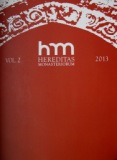„Pamięć obłóczyn kożdy probantki”. Ceremonia obłóczyn w świetle rękopisu Modus suscipiendi novitias ad habitum S. Clarae z 1600 r.
„Memory of veiling ceremony". Ceremony of veiling in the light of the Modus suscipiendi novitias ad habitum S. Clarae manuscript from 1600
Author(s): Olga Miriam PrzybyłowiczSubject(s): History
Published by: Laboratoire de Recherches sur l'Histoire des Congregations et Ordres Religieux (LARHCOR)
Keywords: Poor Clares; novice; ceremony; receiving the habit; Gniezno; manuscript; early modern period
Summary/Abstract: The subject of the analysis is the hitherto unknown in the literature of the subject, the oldest on the Polish lands full veiling ceremony, the adoption of novices – Modus suscipiendi novitias ad habitum S. Clarae (hereinafter: Modus 1600). The manuscript, formerly belonging to the Poor Clares convent in Gniezno, and presently stored in the local Archdiocesan Archive, is dated on the year 1600. The early date of emergence, the minuteness of the ceremony (including musical notation), and brief description of the rite in Polish make it extremely valuable and interesting. The aim of the article is to reconstruct the course of the analysis of the veiling ceremony, having public and solemn character in the opposite to the proffesion vows made in the cloister. The rule of St. Clare from 1253 laconically mentions about receiving habit. Among the Italian Clares, the veil ceremony was known at least since the 15th century. In Poland, first information about ceremony of veiling comes from the second half of 16th century, and ceremonies codifying it became widespread in 17th century. The essential elements of the ceremony included: giving a candle to the novice, the offertory, including placing the ring on the altar, effectuation of the habit and veil, cutting hair, and finally – replacing secular clothing with ecclesiastical robes. In the spiritual area, the manuscript Modus 1600 and other ceremonials present elements of St. Clara’s spirituality and the motive of marriage with the Bridegroom – Jesus.
Journal: Hereditas Monasteriorum
- Issue Year: 2013
- Issue No: 2
- Page Range: 179-194
- Page Count: 16
- Language: Polish

